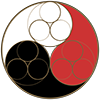
杨露禅 – 现代太极之父
Father of modern Taiji – Yang Lu-Chan
杨露禅生于广平县,被广为铭记是现代太极之父。作为传统,他教授的太极被称为杨氏太极。自此又派生出吴氏太极,孙氏太极及其他少数流派。
Yang Lu-Chan of Guangping, is remembered as the father of Taiji. The art passed on by him was called Yang family (Yangjia) Taiji. From this sprang Wu Taiji, Sun Taiji and most other minor modern styles.
Yang Lu-Chan of Guangping, is remembered as the father of Taiji. The art passed on by him was called Yang family (Yangjia) Taiji. From this sprang Wu Taiji, Sun Taiji and most other minor modern styles.
杨露禅自幼喜爱武术并练习长拳。早年他还学习千载寺的功夫。千载寺位于距离陈家沟30里的博爱县唐村,弘扬佛教、道教和儒教三教合一的理论技艺。杨露禅求学于陈家沟的陈长兴。之后,杨露禅因每战必胜且不重伤对手而蜚声扬名。他精修武术绝技,最终成为人人皆知的"杨无敌"。1850年,杨露禅受聘于王公子弟教授太极拳,任北京紫禁城清旗营武术教官。
As a child, Yang liked martial arts and studied Changquan. At an early age Yang Lu-Chan also studied the art originating in the Qianzai Temple 千載寺 of Tang Village 唐村 in Boai County 博愛縣, about 30 miles from the present Chen Village. Qianzai Temple 千載寺 taught an intelligent synthesis of Buddhism, Daoism and Confucianism. Yang studied with Ch'en Chang-hsing of Chen village. Later Yang became famous for never losing a match and never seriously injuring his opponents. Having refined his martial skill to an extremely high level, Yang Lu-ch'an came to be known as Yang Wudi (楊無敵, Yang the Invincible). In 1850, Yang was hired by the Imperial family to teach Taijiquan to them and several of their élite Manchu Imperial Guards Brigade units in Beijing's Forbidden City.
As a child, Yang liked martial arts and studied Changquan. At an early age Yang Lu-Chan also studied the art originating in the Qianzai Temple 千載寺 of Tang Village 唐村 in Boai County 博愛縣, about 30 miles from the present Chen Village. Qianzai Temple 千載寺 taught an intelligent synthesis of Buddhism, Daoism and Confucianism. Yang studied with Ch'en Chang-hsing of Chen village. Later Yang became famous for never losing a match and never seriously injuring his opponents. Having refined his martial skill to an extremely high level, Yang Lu-ch'an came to be known as Yang Wudi (楊無敵, Yang the Invincible). In 1850, Yang was hired by the Imperial family to teach Taijiquan to them and several of their élite Manchu Imperial Guards Brigade units in Beijing's Forbidden City.
据传杨露禅进京之前,他的拳法被称为"绵拳"或"化拳"。在清廷教拳时,杨露禅遇到诸多挑战,有善意的也有非善意的,但无一例外被他的绵软技艺击败,从而名声大赫。许多达官贵人也会慕名而来观战。某一次,杨露禅击败诸多著名对手,恰翁同龢在场。眼见杨露禅施展技艺,翁同龢受之启发,认为杨露禅的动法如同身体力行演练太极之理论,因而写下对联:"手捧太极震寰宇,胸怀绝技压群英"。自此以来,杨露禅的拳术和由此而生的诸多相关流派,均被称为太极拳。
It is said that before moving to Beijing Yang Lu-Chan's art was referred to as Mian Quan (Cotton Fist) or Hua Quan (Neutralising Fist). While teaching at the Imperial Court, Yang met many challenges, some friendly some not, but invariably his soft techniques prevailed so convincingly that he gained a great reputation. Many who frequented the imperial households would come to view his matches. At one such gathering in which Yang won against several reputable opponents, the scholar Ong TongHe was present. Inspired by the way Yang executed his techniques Ong felt that Yang's movements were a physical expression of the philosophy of Taiji. Ong wrote for him this verse: "Hands Holding Taiji shakes the whole world, a chest containing ultimate skill defeats a gathering of heroes." This was the birth of the art of Taiji. Thereafter, Yang Lu-Chan's art and the styles that sprang from his teaching and by association with him, were referred to as Taijiquan.
It is said that before moving to Beijing Yang Lu-Chan's art was referred to as Mian Quan (Cotton Fist) or Hua Quan (Neutralising Fist). While teaching at the Imperial Court, Yang met many challenges, some friendly some not, but invariably his soft techniques prevailed so convincingly that he gained a great reputation. Many who frequented the imperial households would come to view his matches. At one such gathering in which Yang won against several reputable opponents, the scholar Ong TongHe was present. Inspired by the way Yang executed his techniques Ong felt that Yang's movements were a physical expression of the philosophy of Taiji. Ong wrote for him this verse: "Hands Holding Taiji shakes the whole world, a chest containing ultimate skill defeats a gathering of heroes." This was the birth of the art of Taiji. Thereafter, Yang Lu-Chan's art and the styles that sprang from his teaching and by association with him, were referred to as Taijiquan.
